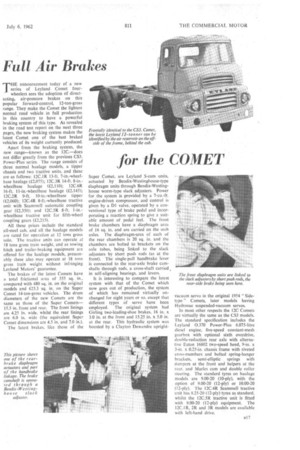Full Air Brakes
Page 51

If you've noticed an error in this article please click here to report it so we can fix it.
THE announcement today of a new series of Leyland Comet fourwheelers sees the adoption of directacting, air-pressure brakes on this popular forward-control, 12-ton-gross range. They make the Comet the lightest normal road vehicle in full production in this country to have a powerful braking system of this type. As revealed in the road test report on the next three pages, the new braking system makes the latest Comet one of the best braked vehicles of its weight currently produced.
Apart from the braking system, the new range-known as the 12C.-does not differ greatly from the previous CS3. Power-Plus series. The range consists of three normal haulage models, a tipper chassis and two tractive units, and these are as follows: 12C.1R 13-ft. 7-in.-wheelbase haulage (12,075); I2C.3R 14-ft. 8-in.wheelbase haulage (12,110); 12C.6R 16-ft. 11-in.-wheelbase haulage (£2,145); 12C.2R 9-ft. 10-in.-wheelbase tipper (£2,060); 12C.4R 8-ft.-wheelbase tractive unit with Scarnmell automatic coupling gear (£2,350); and I2C.5R 8-ft. 1-in.wheelbase tractive unit for fifth-wheel coupling gears (£2,215).
All these prices include the standard all-steel cab, and all the haulage models are rated for operation at 12 tons gross solo. The tractive units can operate at 18 tons gross train weight, and as towing hitch and trailer-braking equipment are offered for the haulage models, presumably these also may operate at 18 tons gross train weight without infringing Leyland Motors' guarantee.
The brakes of the latest Comets have a total frictional area of 555 sq. in., compared with 480 sq. in. on the original models and 623.3 sq. in. on the Super Comet 14-ton-gross vehicles. The drum diameters of the new Comets are the same as those of the Super Comets15.5 in. front and rear. The front linings are 4,25 in. wide, whilst the rear linings are 6.0 in. wide (the equivalent Super Comet dimensions are 4.5 in. and 7.0 in.).
The latest brakes, like those of the Super Comet, are Leyland S-cam units, actuated by Bendix-Westinghouse-type diaphragm units through Bendix-Westinghouse worm-type slack adjusters. Power for the system is provided by a 7-cu.-ft. engine-driven compressor, and control is given by a DI valve, operated by a conventional type of brake pedal and incorporating a reaction spring to give a suitable amount of pedal feel. The front brake chambers have a diaphragm area of 16 sq. in. and are carried on the stub axles. The diaphragm-area of each of the rear chambers is 20 sq. in. and the chambers are bolted to brackets on the axle tubes, being linked to the slack adjusters by short push rods (as at the front). The single-pull handbrake lever is connected to the rear-axle brake camshafts through rods, a cross-shaft carried , in self-aligning bearings, and levers.
It is interesting to compare the latest system with that of the Comet which now goes out of production, the system of which has remained virtually unchanged for eight years or so, except that different types of servo have been employed. The original system had Girling two-leading-shoe brakes, 16 in. x 3.0 in. at the front and 15.25 in. x 5.0 in. at the rear. This hydraulic system was boosted by a Clayton Dewandre upright
vacuum servo in the original 1954 " Sidetype " Comets, later models having Flydrovae suspended-vacuum servos.
In most other respects the 12C Comets are virtually the same as the CS3 models. The standard specification includes the Leyland 0.370 Power-Plus 6.075-litre diesel engine, five-speed constant-mesh gearbox with optional sixth overdrive, double-reduction rear axle with alternative Eaton 16802 two-speed head, 9-in. x 3-in. x 0.25-in, chassis frame with riveted cross-members and bolted spring-hanger brackets, semi-elliptic springs with dampers at the front and helpers at the rear. and Marks cam and double roller steering. The standard tyres on haulage models are 9.00-20 (10-ply), with the option of 9.00-20 (12-ply) or 10.00-20 (12-ply). The 12C.4R Scammell tractive unit has 8.25-20 (12-ply) tyres as standard, whilst the 12C.5R tractive unit is fitted with 9.00-20 (12-ply) equipment. The 12C.IR, 2R and 3R models are available with left-hand drive.




















































































































